Looking forward to the future, new universes will grow in the open ocean of the full-chain game.
Author: Fred @Dacongfred
Navigation Directory
This article is 13,000 words long and will take approximately 10-15 minutes to read.
I. Introduction: What is a full-chain game?
II. Why do humans need full-chain games?
III. Analysis of the current situation of the full-chain game industry
IV. Core advantages of full-chain games
V. Challenges and limitations of full-chain games
VI. Extension of the business model of full-chain games
VII. Conclusion
I. Introduction: What is a full-chain game?
Recently, the Pass card FOMO of the full-chain game Sky Strife has reached 21,000 ETH, which has amazed many non-full-chain game players about the magic of this track. Since the launch of "Pong" in 1972, the game industry has been soaring, from classic 8-bit games like "Super Mario" and "The Legend of Zelda" to highly complex and social network games like "Fortnite" and "League of Legends." Games are no longer just simple entertainment. The social, competitive, and immersive experiences provided by these games have far exceeded our past imagination.
However, with the rise of blockchain technology and the development of cryptocurrencies, the gaming industry is reshaping our experiences in unprecedented ways. From innovative works like Axie Infinity, which tightly integrates games with the crypto economy, to projects like Stepn, which focuses on social and innovation, blockchain games are gradually being seen as the hope for Crypto Mass Adoption. People are beginning to explore new ways of combining games and blockchain, beyond just asset chaining. This has led to the birth of full-chain games.
So, what are the differences between full-chain games and traditional games?
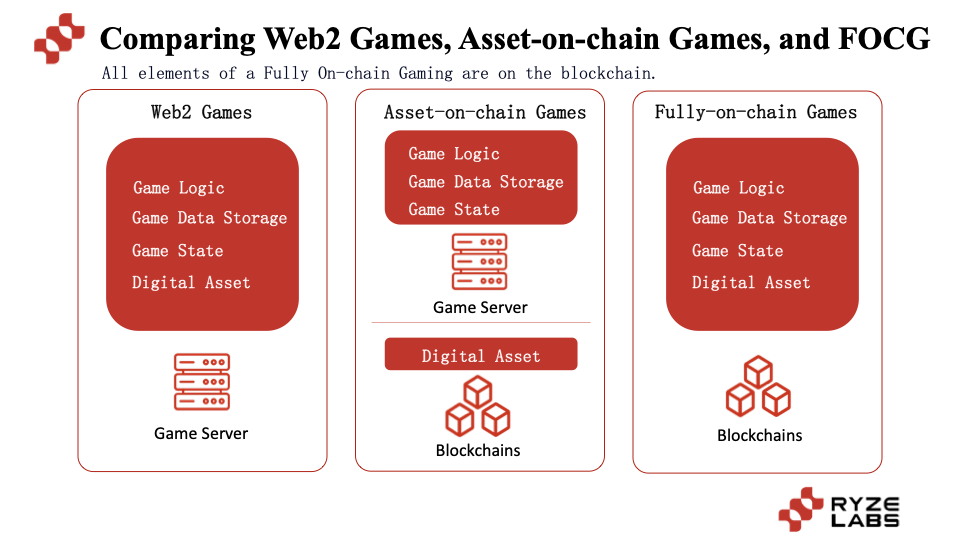
In traditional games, all game logic, data storage, digital assets, and game states are stored in centralized game companies. For example, when we play games like "King of Glory," "Genshin Impact," and "Dungeon & Fighter," all game content, including in-game assets, belongs to centralized companies.
Subsequently, asset-chaining games (commonly known as Web2.5 games), such as Axie and Stepn, chain assets. On one hand, players can own the assets, and on the other hand, it can increase the liquidity of assets. However, when faced with the closure of the game, game assets still face the dilemma of losing their circulation value. The relationship between asset-chaining games and traditional games is more of a supplement rather than a replacement, similar to the relationship between takeout and dining establishments. Similarly, Web2.5 games also face competition from other Web2.5 games and traditional Web2 games.
Recently, the highly anticipated full-chain game has put all interactive behaviors and states of the game on the chain, including the game logic, data storage, digital assets, and game states mentioned earlier, all of which are processed by the blockchain, achieving true decentralized gaming.
For ease of understanding, I summarize the characteristics of full-chain games into the following 4 points:
- The authenticity of data sources is ensured by the blockchain. The blockchain is no longer just an auxiliary storage for data, but the true source of game data; it is not limited to just recording asset ownership, but is the storage center for all key data. This fully utilizes the characteristics of programmable blockchains, achieving transparent data storage and permissionless interoperability.
- Game logic and rules are implemented through smart contracts. For example, various operations in the game can be executed on the chain, ensuring the traceability and security of game logic.
- Game development follows the principles of an open ecosystem. Game contracts and accessible game clients are open source, providing a broad creative space for third-party developers. They can creatively output content and share it with the entire community through plugins, third-party clients, and interoperable smart contracts, or even redeploy and customize their own game experiences.
- The game is independent of the client. This is closely related to the previous three points, because the key to truly encrypting native games is that even if the client of the core developer disappears, the game can still continue. This depends on the permissionless storage of game data, the permissionless execution of logic, and the community's ability to independently interact with core smart contracts, without relying on interfaces provided by the core team. This truly achieves decentralization.
II. Why do humans need full-chain games?
Before understanding why full-chain games are needed, let's briefly understand the current situation and operation mode of the traditional gaming industry.
In essence, full-chain games are also games, and it is very important and necessary for us to understand the operation mode of traditional games in order to understand and analyze the future of full-chain games.
1. Current situation of the traditional gaming industry
With the development of the gaming industry, many excellent Web2 games have emerged during our growth, whether it's FPS games like "Counter-Strike" and "CrossFire," RPG games like "Dungeon & Fighter" and "Dragon Nest," MOBA games like "League of Legends" and "King of Glory," or card games like "Onmyoji" and "Hearthstone." Games have occupied a very important part of our entertainment life as we have grown up.
According to data from Fortune Business Insights, the global gaming market was valued at $249.55 billion in 2022, and is expected to exceed $280 billion in 2023, and will exceed $600 billion by 2030. Compared to the film and entertainment industry, which had a global market size of $94.4 billion in 2022, it can be seen that as a leisure and entertainment industry, games occupy a very important position in economic development, with many aspects of commercial depth and breadth that are worth exploring. It can be said to be the crown jewel of the leisure industry.
1) Why do humans love playing games
According to data from Statista, the number of global gamers has exceeded 2.5 billion, approaching 3 billion. So how can games attract over one-third of the global population to participate? The core reason can be summarized as satisfying various human needs and weaknesses:
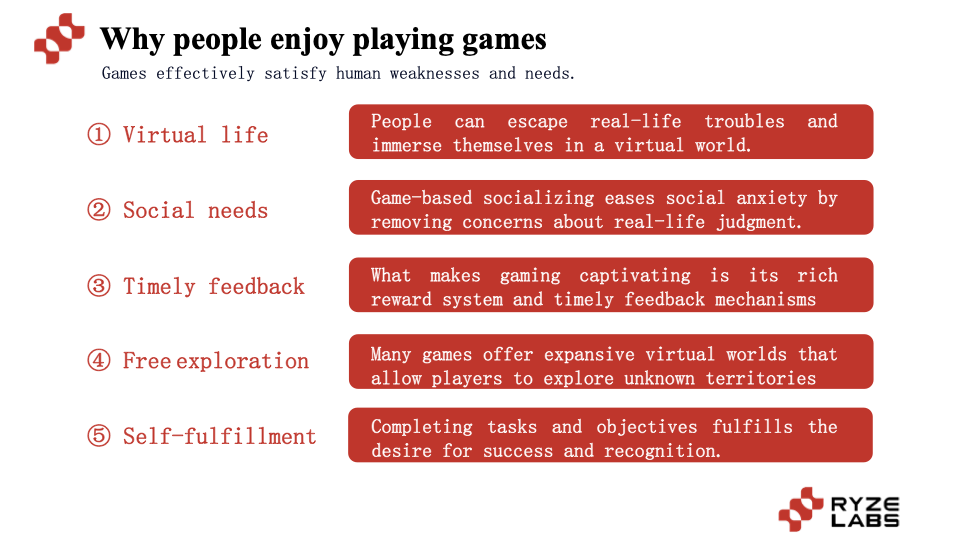
- Restarting life by escaping reality: Games provide a place to escape the pressures and challenges of daily life. In games, people can escape the troubles of reality and immerse themselves in a virtual world, having a second life.
- Social interaction without burden: For multiplayer online games, games provide a platform for social interaction, and are more friendly to social anxiety. Players do not have to worry about the gaze of others in real life, so they can do what they want and build relationships with others.
- Rewards with timely feedback: Unlike the struggles of students and workers in daily life, games are very attractive because they provide a rich reward system and timely reward mechanisms. After putting in effort, leveling up by defeating monsters, and completing challenges, players quickly receive new skills, unlock new levels, or obtain new items. This incentive mechanism can stimulate people to continue moving forward.
- Low-cost freedom of exploration: Many games provide rich virtual worlds, allowing players to explore unknown areas, interact with NPCs and other players, and drive the development of the plot, satisfying the innate human desire for adventure and exploration. In the real world, due to the constraints of money, energy, time, and geographical location, the cost of exploration is much higher compared to the game world.
- Pursuit of achievement and self-realization: By completing a series of tasks and goals, people can achieve the desire for success and recognition, whether it's through leaderboards or achievement points. In games, people can more easily achieve self-challenges and character growth.
Games can cleverly satisfy different users' needs and preferences, whether in terms of the breadth of coverage or providing deep immersive experiences.
2) Current situation and development of traditional games
Next, let's briefly understand the current situation of the traditional gaming industry.
In traditional games, they are generally divided into Shooter, Adventure, Role Playing, Battle Royale, Strategy, Sports, Puzzle, Action, Simulation, and other game types.
According to data from Newzoo, role-playing and adventure games perform well on PC, mobile, and console platforms, ranking in the top five. Additionally, shooting and battle royale games are very popular on PC and console platforms. On mobile platforms, puzzle and idle games are also popular among users.
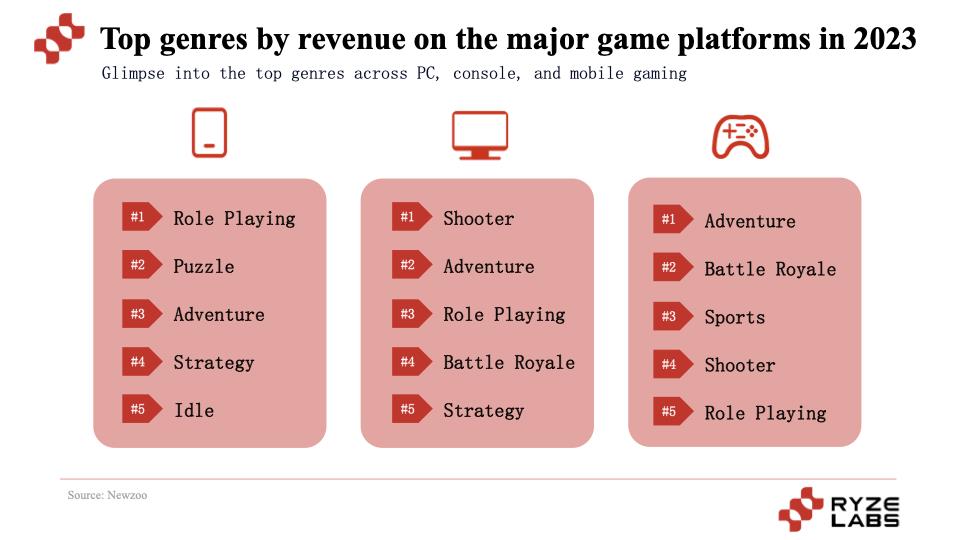
2. Challenges in the traditional gaming industry
However, the traditional gaming industry currently faces two major challenges: game releases are restricted by licenses, and the high costs before game releases lead to slow recoupment periods and potential hidden costs.
1) Restrictions on game releases due to licenses
Game licenses refer to specific permits issued by governments in some countries or regions for game releases. This system aims to regulate game content, ensure that games comply with national or regional regulations, culture, and values, protect minors from inappropriate content, and maintain social stability.
For example, in Germany, game content is subject to strict scrutiny, especially focusing on content that may have a negative impact on young people. South Korea and Japan have game rating systems evaluated and issued by relevant national agencies.
In China, the impact of game licenses is even more significant. China implements a strict game license system, which is issued by the National Radio and Television Administration. Games need to obtain a license before they can be released in the Chinese market.
After the release of 87 licenses on July 22, 2021, there was a long period of stagnation until April 2022 when a turnaround gradually began. In April 2022, 45 licenses were issued, and more licenses were announced in September and December. However, during the period of license approval stagnation from 2021 to April 2022, only a few large companies survived, and a large number of small and medium-sized game companies faced closure. According to data from the Tianyancha app, more than 14,000 small and medium-sized game companies (with registered capital below 10 million) were deregistered from July to December 2021.
China, as the world's largest gaming market, has over 500 million gamers. However, the license issue has become a pain point for numerous Chinese companies. Even after the resumption of license issuance, the contraction and continuous adjustments of licenses have become a sword of Damocles for every game project. During the days of waiting for license issuance, many project owners can be heard sighing about the lack of funding.
2) High costs before release, and the potential for hidden costs
In the development model of Web2 games, the early stages of game development require upfront costs for human resources and infrastructure. There are idle time costs during the waiting period for licenses, and profit-sharing can only occur after the release of the license, game distribution, and the generation of commercial revenue.
It is easy to see that a large amount of costs are incurred in the early stages. If there are problems during the development, licensing, and user acquisition stages, all the previous costs become sunk costs. For a medium-sized game, the costs are generally in the millions of dollars. The long and costly development and distribution process leads to a very long profit cycle, resulting in a high risk of achieving expected returns.
3. Attempts to break through in the Web2.5 game industry
Faced with these two challenges, Web2.5 games have taken the lead in breaking through. On one hand, Web2.5 games bypass the restrictions of domestic licenses by targeting global users, allowing citizens of the world to play. On the other hand, by issuing NFTs and tokens, Web2.5 games can generate income through liquidity mining at the early testing and launch stages, greatly reducing the financial barriers to game production.
In the attempts to break through in the Web2.5 game industry, games like Axie and Stepn have emerged, which have gained significant attention. Axie's popularity in Southeast Asia has led many people to earn a living through Axie, with income exceeding the average per capita income in the Philippines. Stepn's "move to earn" model has attracted the attention of many non-Web3 users, sparking a trend of breaking through the barriers of blockchain games. However, with the collapse of Ponzi's economic model, Web2.5 games have not been able to replicate the success of Axie and Stepn.
Builders have also begun to explore different directions. Some are trying to compete in the Web2 market by targeting AAA titles, but this has led to competition with both Web2.5 and Web2 games. Another wave of people has decided to turn to full-chain games to explore new possibilities and validate their value. In this emerging industry of Web3, there are always pioneers who want to move forward on a completely new path.
III. Analysis of the current situation of the full-chain game industry
The entire full-chain game industry is currently in a very early stage of development, both in terms of game projects and related infrastructure. In the industry map of the full-chain game field, it can be roughly divided into four categories: full-chain game projects, full-chain game engines, full-chain game chains, and full-chain game distribution platforms.
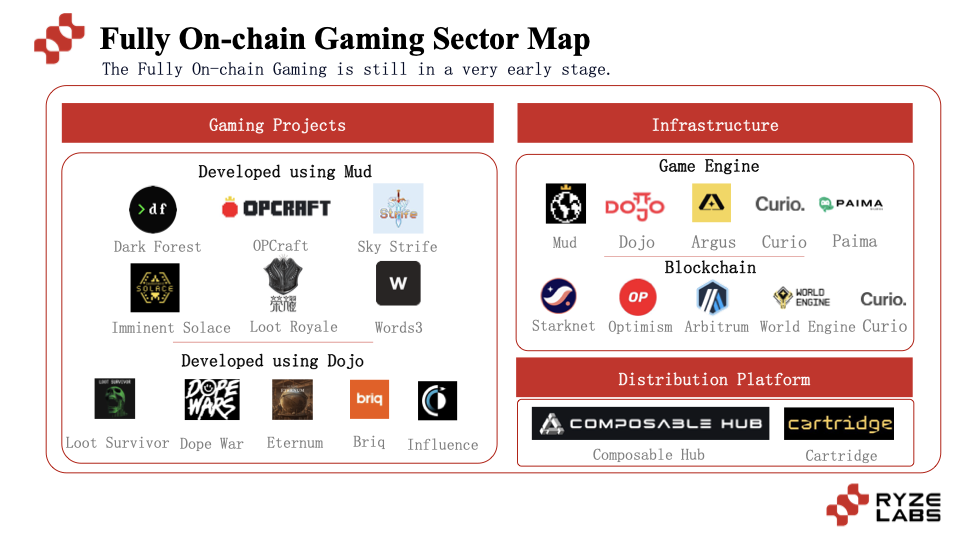
1. Full-chain game projects
Currently, full-chain game projects are still in a very early stage. Let's analyze a few full-chain game projects to understand the current state of full-chain games.
In terms of game projects, there are early well-known projects like Dark Forest, as well as recent ones like Loot Survivor, Sky Strife, Imminent Solace, and Loot Royale. Most of the playable projects are still in the testing phase, and the number of playable full-chain games on the market is less than ten. The games are mainly strategy games, and there are also many new projects attempting simulation and management directions.
Since most games are still in the development and unplayable stages, I will mainly introduce a few playable and distinctive full-chain games here.
1) Dark Forest
First, let's take a look at the representative work of full-chain games, Dark Forest. In simple terms, Dark Forest is a decentralized strategy game created on Ethereum using zkSNARKs.
Dark Forest was developed by Brian Gu, a graduate of MIT, under the pseudonym Gubsheep. Some of the inspiration comes from Liu Cixin's science fiction novel "The Dark Forest." Other team members include Alan, Ivan, and Moe. This game project is not funded, but the team's new project, Argus Labs, recently raised $10 million.
Dark Forest is one of the earliest incomplete information games built on a decentralized system. As a space conquest strategy game, players explore the infinite universe by starting their journey on their own planet, discovering and occupying other planets and resources to develop their empire.
The three main highlights of Dark Forest are: first, all game logic, data, and states are on the chain, and centralized entities cannot control the results of their actions; second, a freely open and highly combinable game ecosystem: the open-source full-chain game mode gives Dark Forest permissionless interoperability, essentially an Ethereum smart contract that any address can interact with, giving rise to a thriving derivative ecosystem (plugins) and generating a larger community.
For example, Project Sophon has developed a local library for Dark Forest, allowing users to start a game on-chain or off-chain. The Ukrainian game organization Orden_GG has built an artifact trading market and added liquidity pools. MarrowDAO|GuildW @marrowdao, a Chinese DAO, has developed several plugins, including an artifact trading market and GPU mapping tools, making its UGC ecosystem very interesting.
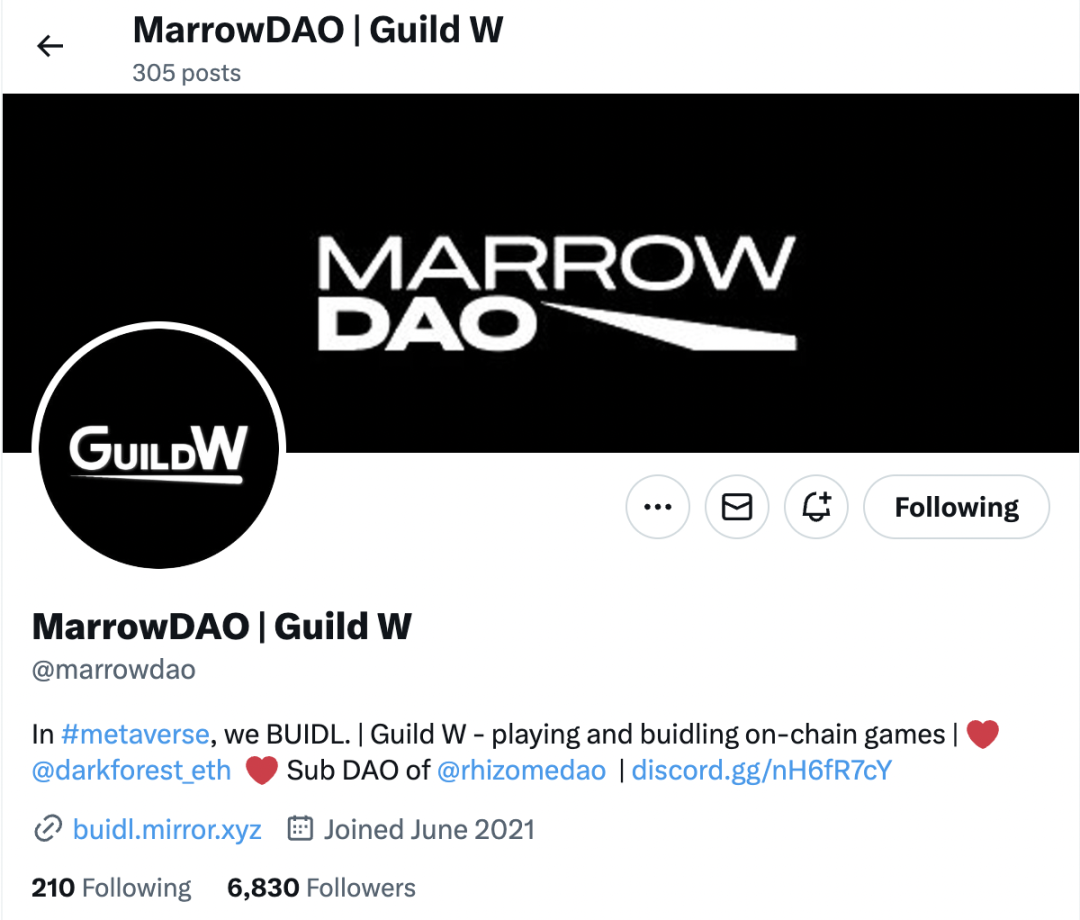
(Source: MarrowDAO Official Twitter)
Another major highlight of Dark Forest is the use of zk-SNARKS technology for information hiding. In strategy games, if all information is transparent, opponents will know the player's position, making it impossible to implement strategic countermeasures in a fully open and transparent environment. Dark Forest uses zk technology to hide most of the universe and opponents when players enter the game for the first time. They only become visible when players explore the hidden areas. Each time a player moves, they send a proof to the blockchain to validate the move without revealing their coordinates in the universe.
Since the official v0.6 version Round 5 ended in February 2022, Dark Forest has not opened a new round of game versions. The game is currently in a nurturing state, and those interested in experiencing the game can participate in rounds organized by community organizations, such as creating a small universe in the Arena system developed by dfDAO.
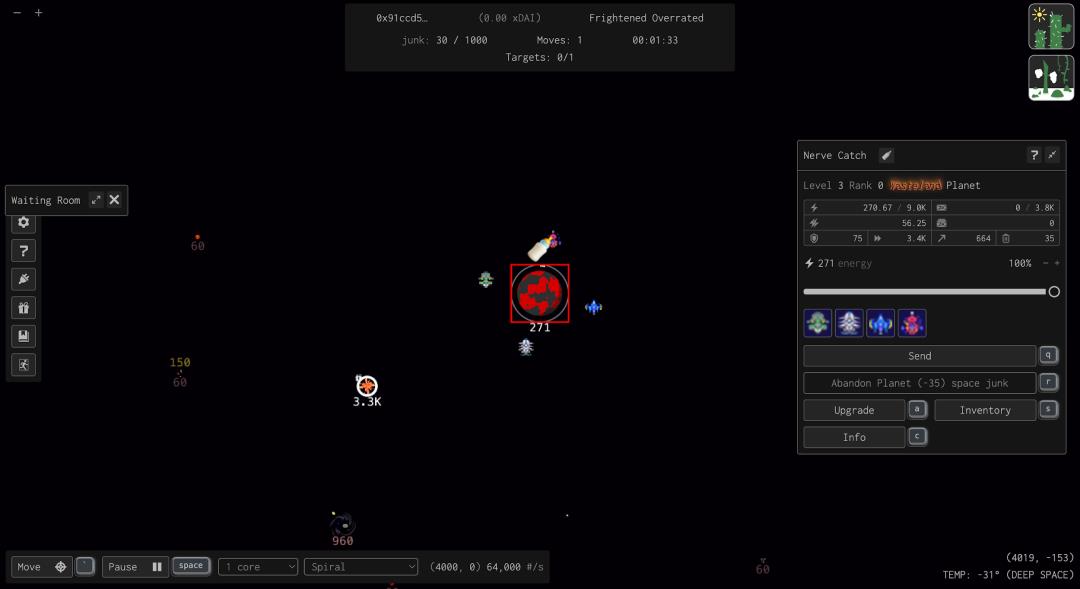
(Source: Fred creating a new universe in the Arena system developed by dfDAO)
Overall, Dark Forest has redefined the possibilities of Web3 games. Many people praise "The Dark Forest" as a perfect example of the intersection of games and cryptography, inspiring many subsequent full-chain game projects. According to previous reports, the total number of historical players has exceeded 10,000+.
However, the significance of Dark Forest goes beyond the game itself. As the first highly anticipated full-chain game, it is more like a spiritual totem of full-chain games, allowing industry builders to discover that there are so many freely open combinable gameplay styles and a thriving derivative ecosystem based on full-chain games. This has given people a stronger confidence in the possibility of achieving "Autonomous Worlds."
After creating Dark Forest, the Dark Forest team and several other teams formed 0xPARC. The sub-project Lattice of 0xPARC discovered that the existing development costs for full-chain games were extremely high. Therefore, in 2022, they started the MUD project to develop a user-friendly full-chain game engine based on the ECS framework, aiming to solve issues such as contract-client state synchronization, continuous content updates, and interoperability with other contracts, thereby lowering the development threshold and greatly promoting the development of full-chain games. In a sense, Dark Forest is a huge symbol and booster for the full-chain game industry.
2) Loot Survivor
Next, let's take a look at Loot Survivor, a game developed by the BibliothecaDAO team. Loot Survivor is an important part of the Loot ecosystem.
Loot was released on August 28, 2021, by @Dom Hofmann. Unlike common PFP-type NFTs such as BAYC and Crypto Punks, each NFT of Loot is a white text on a black background, and the interpretation of this text is very open and community-driven. This characteristic has attracted a large number of ecosystem contributors and related derivative projects.
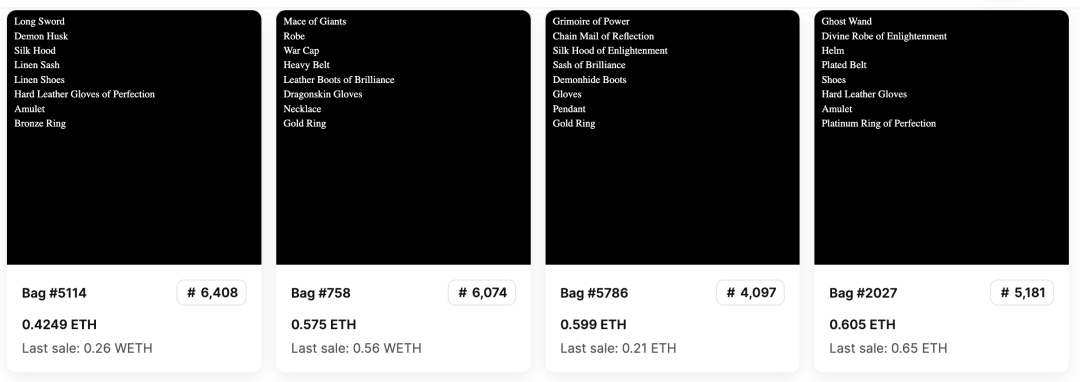
(Source: OpenSea)
Loot Realms has been dedicated to the development of the Lootverse since its launch on September 1, 2021. Core contributors @lordOfAFew and @TimshelXYZ played important roles in building the underlying narrative of Loot and presented a narrative gamification through the first project of Realms, Eternum.
In February 2022, the team proposed the core concept of "Play 2 Die," initially planned as an expansion of the Realms series, titled "Realms: Adventurers." However, during the iterative development process, the team decided to quickly launch a smaller single-player full-chain game, giving birth to Loot Survivor.
Loot Survivor is a text-based dungeon or roguelike game that made its debut at the full-chain game summit in Lisbon on May 25, 2021 (also the author's birthday) and received significant attention.
The overall gameplay of the game is relatively simple, involving monster battles through text interactions until the player dies, and it encourages users to challenge themselves through a leaderboard.
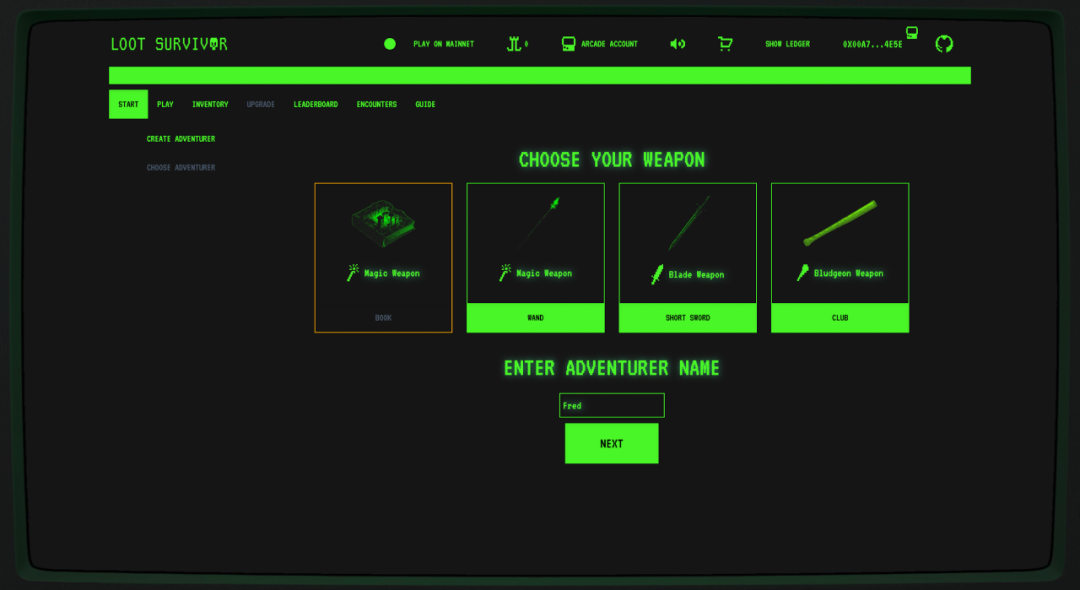
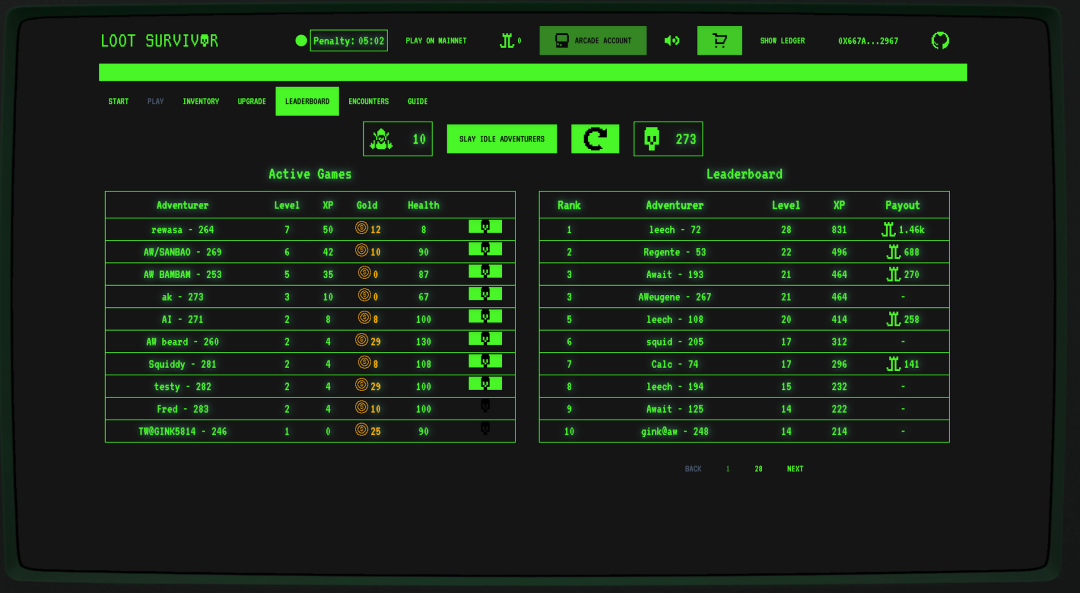
(Source: Fred's in-game screenshots and performance rankings in Loot Survivor)
Overall, the game has a small scale and playability, inheriting the gamified narrative of the Loot ecosystem. As one of the flagship projects in the Dojo engine ecosystem, it has also given a boost to the Dojo engine and Starknet ecosystems.
3) Imminent Solace
Imminent Solace is a recently launched battle royale game based on ZK War Fog and developed using the Mud engine. The project team is developed by PTA DAO, a Chinese team that is very focused on full-chain games. It combines PVP looting, autonomous world exploration, and PoW resource mining. The gameplay is similar to Dark Forest, but with higher ease of operation and user experience.
The ultimate goal of the project is to create a war simulation game similar to EVE, where players will face real losses in resources and assets during gameplay and need to face strategic challenges.
Imminent Solace is one of the relatively playable games among the recent full-chain games, with good game interaction and experience.
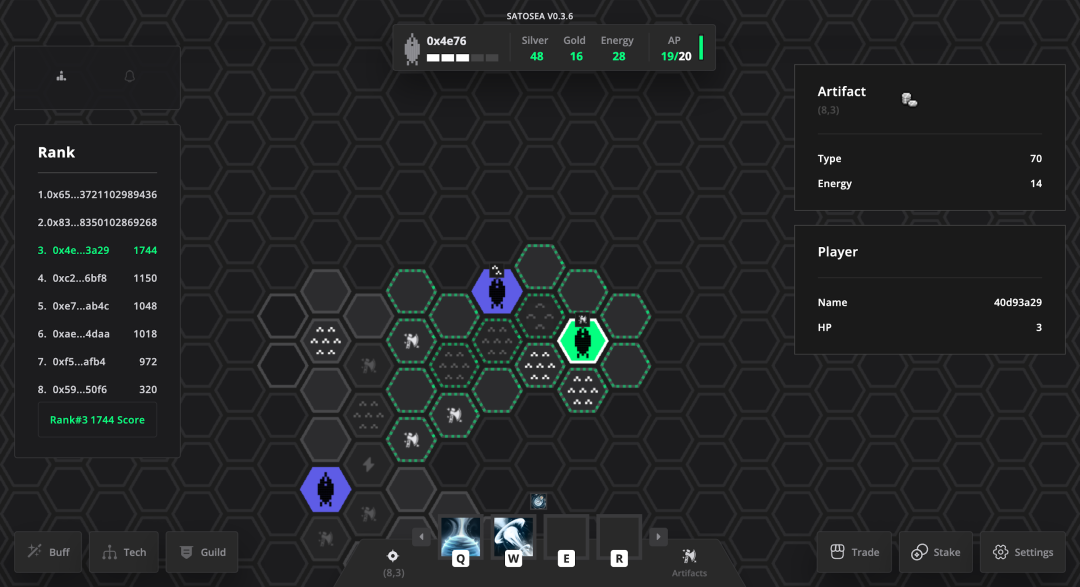
(Source: Fred's in-game screenshots and rankings in Imminent Solace)
In addition, there are other games exploring the path of full-chain games, such as Sky Strife developed by Lattice, OPCraft, the text-based game Word3 by SmallBrain, the Web3 version of Werewolf Framed, and battle royale games like Loot Rayale, as well as management games like Genki Cats. Most of these games are still in the testing phase, and there are currently only a few playable games in development.
Through research, it has been found that current full-chain games are mostly web-based, with almost no PC or mobile versions.
On the one hand, this is related to the characteristic of not needing a client for full-chain games. Since full-chain games can have multiple front ends, the most important thing for project teams is to quickly create an MVP version for the community and users to play. Web development is faster and cheaper than PC and mobile development, making it the optimal or even the only choice for many.
On the other hand, full-chain games are still in the concept verification stage, and it is crucial to quickly create playable games to validate their value.
2. Full-Chain Game Engines
Before understanding full-chain game engines, let's first understand the core essence of engines:
In simple terms, it's like standing on the shoulders of giants to see the world. Game engines integrate common game development functions into reusable code, allowing developers to focus on creating unique game content without reinventing the wheel.
For example, in traditional game engines like Unity and Unreal Engine, game developers can use existing engines to implement things like the motion laws of a universe explosion or the trajectory of movement after collisions between characters, without having to start from scratch.
Similarly, full-chain game engines aim to achieve a similar purpose. Compared to traditional game engines like Unity and Unreal Engine, which can handle tasks such as graphics rendering, physics simulation, and network communication, full-chain game engines, due to the nature of their games, focus more on issues such as contract-client state synchronization, continuous content updates, and interoperability with other contracts.
Currently, full-chain game engines include Mud, Dojo, Argus, Curio, and Paima, among others. Mud and Dojo are currently the two most mainstream full-chain game engines, creating a situation of EVM-compatible and Starknet ecosystems vying for dominance. Here, we will mainly introduce these two game engines.
Mud
Mud is the first full-chain game engine officially released by Lattice in November 2022. The Mud team, Lattice, and the full-chain game pioneer Dark Forest belong to the OxPARC team. As the earliest full-chain game engine, Mud currently has the most developers in its ecosystem. In addition to the original Dark Forest, projects such as OPCraft, Sky Strife, Word3, and the recent Imminent Solace have emerged, making it the full-chain game engine with the most developers at present.
Dojo
Dojo was born out of the Starknet ecosystem and was initially developed around MUD in the Starknet's Cairo language. It was officially released in February 2023. The core developer tarrence.eth is enthusiastic about the Cairo language, believing that it has greater advantages in proof recursion and step-by-step proof compared to the solidity language.
However, another core developer, Loaf, indicated that the decision to create a Mud-like engine on Starknet was not because Mud was inadequate, but because they wanted to build an ECS system on Starknet and chose to fork MUD for this purpose. Similarly, some other Layer1/Layer2 projects have also forked their own engines to develop their full-chain game ecosystems, such as Move and Flow. Essentially, this is to promote the prosperity of on-chain ecosystems and choose to build the infrastructure for full-chain games.
The Dojo ecosystem, backed by the large IP of the Loot ecosystem, has also seen many impressive projects, including Loot Survivor and Loot Realms: Eternum. Additionally, other projects such as Dope Wars and Influence have also shown promise.
Just as traditional game engines have played an important role in promoting the development of the gaming industry, the rise of full-chain games and the emergence of full-chain game engines are closely related. The appearance of Mud and Dojo has propelled the development of the entire full-chain game track, nurturing it through events like the ETH AW Hackathon, Pragma Cario 1.0 Hackathon, and Lambda zkWeek Hackathon in May, June, and July of this year.
3. Full-Chain Game Chains
In the field of game-specific chains, compared to the previously popular game-specific chains in Web2.5 games (not listed one by one), current full-chain game projects prefer to build on some general Layer2 solutions such as Arbitrum Nova, Optimism, and Starknet.
The fundamental reason is that the user profiles of previous game-specific chains were mainly players who enjoyed playing Web2.5 chain games and AAA-type games, and these players are not very interested in the relatively simple and rough content of full-chain games. This has led to the so-called game-specific chains not being very attractive for full-chain games.
In addition, it is worth noting that CaptainZ has mentioned a contradiction in putting all games on the chain: the contradiction between the push-based nature of blockchain and the loop-based nature of games.
Many blockchains are event-driven and passively trigger updates, only updating the state when new transactions or operations occur. In many existing applications, many tracks are very compatible with this framework. For example, in the DeFi track, when a user wants to trade two tokens on Uniswap, the trade is executed after the user submits it, and this process is event-driven. Similarly, many social platforms are also event-driven. For example, when you post a tweet on Twitter, the tweet is published for others to see, which is also event-driven, similar to blockchain.
However, many traditional game architectures are loop-based (except for some asynchronous games such as turn-based and board games), where the game system actively processes user input, updates the game state, and renders the game world in each loop, known as a Game Loop or Tick. Many games may require dozens or even hundreds of ticks per second to ensure continuous gameplay.
This natural contradiction between game logic and current blockchain logic presents a challenge. In response to this situation, some teams have begun to build proprietary chains specifically for full-chain games, also known as Ticking chains.
For example, the Argus team is building a new Layer2 based on Polaris (an EVM module compatible with the Cosmos SDK) with a precompiled ticking function, called World Engine. Curio is also building a new Layer2 based on OPStack, also with a precompiled ticking function.
Although still in the development stage, there is great anticipation for the emergence of new roll-up constructed chains specifically for full-chain games, which is believed to further drive the development of full-chain games.
4. Full-Chain Game Aggregators/Publishing Platforms
Finally, let's also introduce the aggregators/publishing platforms for full-chain games, which are still in the early stages. Currently, due to the very early stage of full-chain games, there are very few playable full-chain games available. According to Composable Hub's data, including alpha, beta, and fully launched games, the number of playable games does not exceed 30.
Therefore, for full-chain game players, finding full-chain games currently relies mainly on word of mouth and some small community dissemination. There are not many aggregators to help users explore and choose full-chain games, unlike mature tracks like DeFi and GameFi.
Currently, there are two main platforms dedicated to full-chain game aggregation: Composable Hub and Cartridge.
Composable Hub
Composable Hub is a full-chain game aggregation platform under Composablelabs. Composablelabs also operates the Web2.5 GameFi aggregation platform Klick and the NFT DEX Lino Swap.
Currently, Composable Hub aggregates 56 full-chain games, including 14 fully launched games, 12 games in the testing phase, and 30 games still in development.
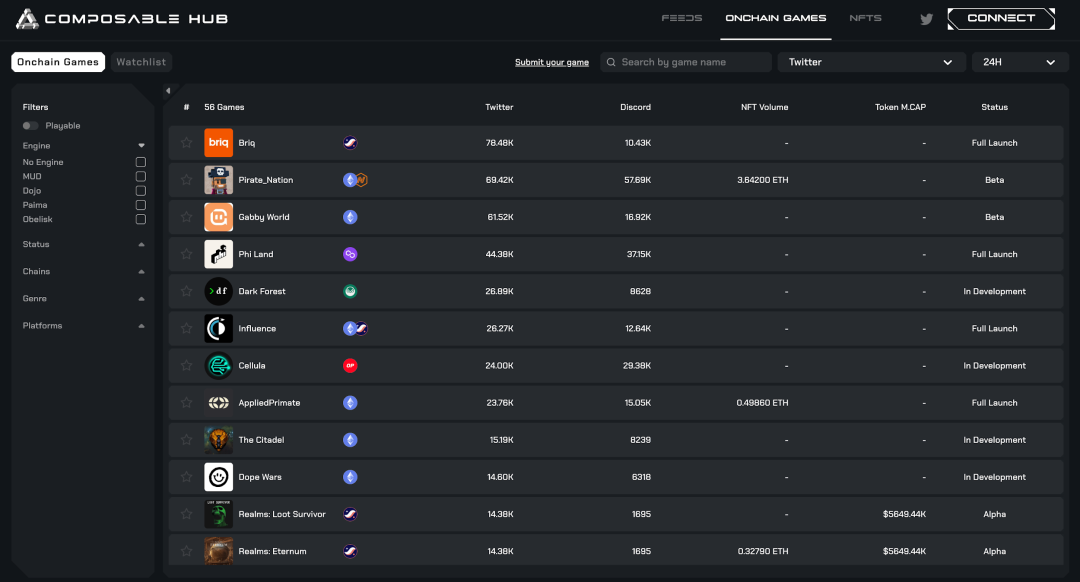
(Source: Composable Hub)
Cartridge
Cartridge is a full-chain game aggregator in the Starkware ecosystem, dedicated to creating a Web3 Steam. It currently aggregates 5 games from the Starknet ecosystem: Dope Wars-Roll Your Own, Influence, Loot survivor, Briq, and Frens Land.
Additionally, the Cartridge team has been actively promoting the development of the Dope Wars-Roll Your Own game and is also a core contributing team to the Dojo engine.
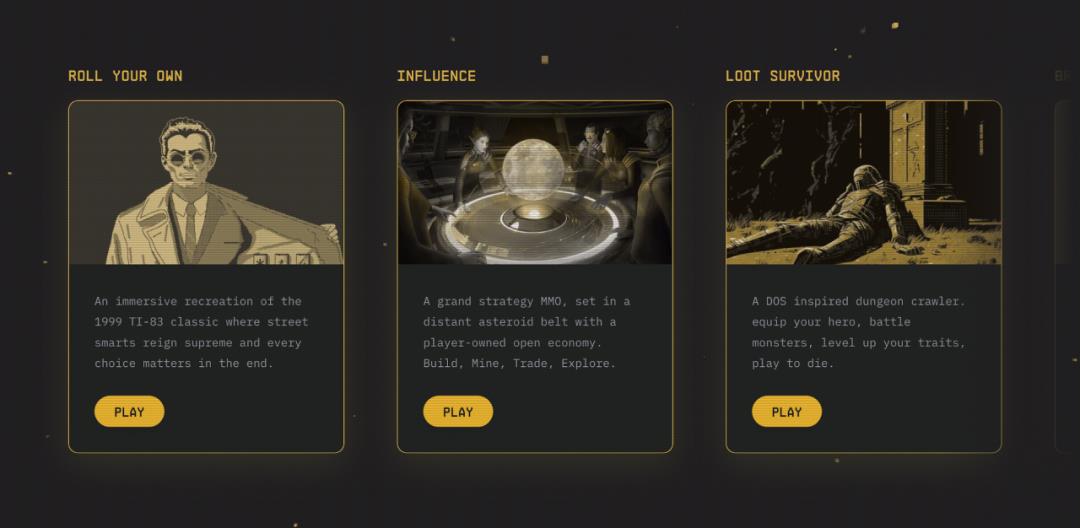
(Source: Cartridge)
IV. Core Advantages of Full-Chain Games
In general, full-chain games make games more fair by putting game logic, state, data storage, and assets on the chain. Additionally, because game contracts and accessible game clients are open source, they provide a broad autonomous space for third-party developers, allowing games to have more community and third-party developed rules and gameplay.
This openness allows games to transition from a binary division where game companies are providers and players are consumers to a new model where every player can become a builder and creator of the game.
1. From PGR to UGR, Giving Everyone the Right to Be a Deity
In traditional games, all game content is provided by the official company, and players are participants in the PGC (Professional Generated Content) mode, whether playing games like Honor of Kings, Genshin Impact, Fortnite, or Overwatch. Of course, players have the right to create content around the game, such as character roles and novel writing, to some extent, achieving UGC (User Generated Content).
However, this type of creation does not involve the core rules and gameplay. Players can only consume game rules rather than create them. They have no control over the strengthening or weakening of game characters, game values, or environmental collisions. They are still within the framework of PGR (Professional Generated Rules). For players who desire to create, this is a kind of shackle. In the real world, humans who are disappointed always desire the right to be a deity, longing for UGR (User Generated Rules), whether through novels, movies, or games.
Most traditional games are not willing to make open attempts due to considerations such as business models, security, and stability. However, in many games, some projects are transitioning to openness and PGR, using mods to allow other developers to develop game content outside the official content. The most well-known example is Minecraft, which allows players to create and run their own game servers. Third-party developers can implement custom game modes, rules, and content, creating gameplay different from the original game, including Minecraft versions of Battle Royale and even online graduation ceremonies during the pandemic.
Although Minecraft allows users to create multiple servers for game modes, these new servers are isolated from each other and do not interconnect. The data accumulated by players in this gameplay cannot be circulated in new gameplay servers. This UGR is castrated, creating one's own small universe rather than a shared universe.
The difference in full-chain games is that they share the same backend, and the interaction of different mods and smart contracts only affects the frontend, allowing data to be shared and circulated among different clients.
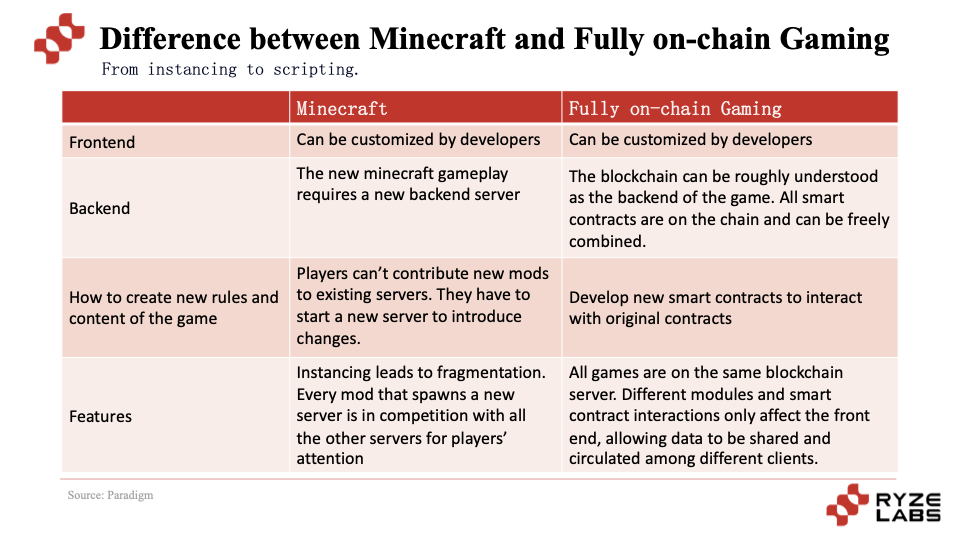
Due to the on-chain nature of game logic and rules, and support for permissionless interoperability, full-chain games allow players to freely build and create various game features and experiences. These features include trading markets, embedded games, custom clients, etc., making the game experience more diverse and achieving the transition from PGR to UGR.
This also reminds me of the virtual world of Jiuzhou collectively created by Chinese online writers Jiang Nan, Jinhe Zai, and Dajiao. Through collective storytelling, they created a Jiuzhou universe, which has expanded from literary works to the film, gaming, and other industries, forming a vast world.
In fact, in comparison to our lives, full-chain games are very similar to playing cards. Playing cards themselves have fixed suits and numbers, but people have developed various gameplay, such as Landlord, Texas Hold'em, Tractor, Upgrading, Panic, and Golden Flower, demonstrating the diversity and flexibility of game rules. Full-chain games are the same. Through support for open creation and interoperability, players can build various game experiences based on basic rules. In traditional games, everyone can only be a game consumer, but in full-chain games, people can be game rule makers.
In summary, the advantages of full-chain games lie in their openness and permissiveness, giving players greater creativity and freedom to participate in the creation of game rules and content, forming a diverse, personalized, and vibrant game ecosystem.
2. Fairness and Transparency, Experience an Unmanipulated Game Environment
Another major advantage of full-chain games is the transparency of game logic and rules after being fully put on the chain.
Especially for games of chance and gambling, fairness and transparency are crucial.
Just like in the popular movie "Uncut Gems," the gambling apps used by players are controlled by centralized companies, and all results may not be random but predetermined. For games like Poker, Golden Flower, and other gambling card games, the lack of transparency in game processes and states can lead to countless players being deceived, which is one of the reasons why many Web2 games with monetary elements are widely criticized.
The transparency of game logic and rules in full-chain games ensures the openness and transparency of rules. When combined with some encryption technologies (such as the war fog game Dark Forest and Imminent Solace combining ZK-SNARK), it allows game types that require fairness to experience what Web2 and Web2.5 games find difficult to achieve.
V. Challenges and Limitations of Full-Chain Games
As the infrastructure continues to improve, the wind of full-chain games has begun to blow. However, despite some unique highlights, full-chain games still have many limitations and challenges to face:
1. Poor User Experience
Overall, players of full-chain games have a consensus that the current playability of full-chain games is generally much worse than that of Web2 and Web2.5 games. On the one hand, most full-chain games currently have relatively primitive or rough graphics, and on the other hand, there are the following four aspects of interaction experience:
1) Difficult Start: Difficult to Match with Fellow Players
For multiplayer PVP games, it often requires 4 players to play together. However, due to the current scarcity of players in full-chain games, the number of players online often does not exceed single digits. Coupled with the lack of a matchmaking mechanism, many multiplayer games can only be played by creating private rooms and inviting players, which easily leads to a loss of interest in the game at the beginning stages.
2) Authenticity or Inauthenticity: High Artificial Barriers in Some Games
In addition to the gaming experience, many games also set many artificial barriers. For example, some games can only be played at specific times, some games require an entry fee before playing, such as purchasing certain tokens or NFTs to play, thereby increasing the cost for players.
Some game developers maintain the spirit of independent game developers, believing that paying for games is the most authentic belief. However, in Web2, independent games at least have some innovative gameplay or high-quality content to attract players.
However, facing the current low playability of most full-chain games, why would users be willing to spend money on a game that they wouldn't even give a second glance in Web2? This has reinforced the stereotype that many game players and the outside world often have about full-chain games being self-indulgent. Apart from a few individual projects and believers, how many people are really willing to play? Many players who are willing to play test versions of games are doing it out of passion, and the behavior of these project teams is somewhat discouraging for players.
3) Poor Gaming Experience: Frequent Bugs
For players, what full-chain games need most is faith, followed by patience.
From PC to mobile, game development has generally been moving towards more convenient methods.
In full-chain games, a common scenario is that when a few players agree to play a full-chain game together, they often encounter bugs most of the time, whether it's page refreshes or various unexpected errors. It's difficult for impatient people to complete the entire process of experiencing a full-chain game.
4) Loud Thunder, Little Rain: Grand Narrative, Extremely Low Playability
Currently, most game projects have a grand narrative but very low playability in practice. Most games are even more difficult to play than web games from over a decade ago. It is hoped that with the improvement of infrastructure and the participation of more builders, the playability of full-chain games can gradually narrow the gap with Web2 games.
2. Limitations of Game Types
Due to the current performance of blockchain and the incomplete infrastructure, not all game types are suitable for full-chain games.
From the current types of full-chain games, it can be seen that SLG (strategy) games are predominant. These games do not have high real-time requirements, unlike RPG, AVG, ACT, and MOBA game types, which require continuous and real-time state updates. If all data exists on the chain, the current blockchain performance still cannot support real-time requirements, making these game types not very suitable for full-chain games at the moment.
Currently, full-chain games are mainly divided into two development directions. One is to take the route of being small and beautiful, accumulating users through playable MVP versions, such as simulation management, pet raising, tower defense, and other lightweight playable game types. The other is to take the route of grand narratives and open worlds, creating an imaginative ecosystem through grand worldviews and cosmic narratives. However, due to the limitations of game types, it is basically limited to the above game types. How to create a game that breaks the mold like the next Axie or Stepn still requires our collective exploration.
3. Genuine Demand or False Demand
The biggest challenge and controversy surrounding full-chain games currently come from whether the demand is genuine.
Taking the two core advantages of full-chain games as an example:
1) From PGR to UGR, on the one hand, many open games in Web2 can achieve this, such as Minecraft. On the other hand, there is a question mark regarding whether server data needs to circulate among different game clients. For example, whether mounts, level 90 characters, and flying wings in RPG-type clients need to circulate to MOBA games. The necessity of this still needs to be explored.
2) Fairness and transparency, currently mainly reflected in gambling games. However, on the one hand, the number of online gamblers is much smaller than offline gamblers (in 2023, the number of online gamblers was 120 million, while the global number of gamblers is approximately 4.2 billion per year). The ceiling is not high. On the other hand, for true gamblers, what they care most about is the convenience of deposits and withdrawals. Compared to fairness, gamblers are more concerned about the speed of fund and chip exchanges and whether the experience is convenient. With significant differences in full-chain game infrastructure, this is a major weakness of current Web3 games.
Surrounding the two major features of full-chain games, UGR and fairness, if there are some categories in the future that can make good use of these two features, perhaps it can address the genuine demand of game players and attract more people to participate. However, as of now, the road ahead is still long and arduous.
4. Completely Decentralized Games Are Not Necessarily Fun, and May Cause Chaos Instead
Like a coin with two sides, the other side of openness is chaos. Due to human nature being lazy, for players who only want to consume and not create, those accustomed to the traditional PGR mode of games are most concerned about the playability of the game.
It is difficult for the true game designers to delegate the game's content to others because each user's abilities are different. Ordinary game players may design games from their own perspectives, making it difficult to grasp the playability and balance of the game.
Whether professional matters should be left to professional game developers or given to everyone is a very worthwhile real-world issue to explore. Achieving a balance between democracy and elitism is a challenge.
Therefore, for the development team of full-chain games, it is crucial to have interesting and stable core gameplay, while leaving space for players to create and extend new gameplay. Achieving this balance is important. Otherwise, it is easy to fall into the extremes of overly centralized games or games that are too hollow to attract players to participate in creating new gameplay.
For the full-chain game development team, playing the role of "initial deity," designing the core gameplay of the game well, and attracting more players to collectively create and enrich this game world through reasonable incentive mechanisms are crucial.
VI. Extended Thoughts on the Business Model of Full-Chain Games
Finally, let's explore the topic of the business model of full-chain games, which is of great concern to both project teams and investors.
First, let's analyze the business model of traditional games. The commercial evolution of traditional electronic games has gone through several stages, constantly changing with the development of technology, market changes, and the evolution of player needs:
- 1970s: Coin-operated Mechanism - The earliest consumer-facing electronic games can be traced back to arcade games in the 1970s and 1980s. During this period, due to the hardware requirements for running electronic games, each game was placed in independent physical devices, including games like Pac-Man and Galaga, where players inserted coins to exchange for game time or lives.
- 1980s: One-time Purchase - Early electronic games were mainly console games, sold through retail channels, where players purchased physical game cartridges or discs. This was a product sales-oriented era, where players made a one-time purchase to play the game.
- Mid-1990s: Subscription Model - With the popularity of the internet, multiplayer online games began to rise. Some game companies introduced subscription services, where players had to pay a monthly fee to access game servers. An example is "World of Warcraft."
- Mid-2000s: Ad-based Model + Item Sales - Free-to-play games emerged, where the game itself was provided for free, but players could purchase virtual items or in-game currency to obtain additional items. Some games also used an ad-based model to generate revenue by displaying ads in the game.
- Early 2010s: Item Sales Model - With the popularity of smartphones, mobile games became mainstream. In-app purchases became a major revenue model, allowing players to purchase various items within the app to unlock features or accelerate game progress.
- 2020s: Cloud Gaming Subscription Model - Recently, cloud gaming has also entered people's field of vision, allowing players to stream games through cloud servers without the need to download and install. Additionally, some game subscription services such as Xbox Game Pass and PlayStation Now have begun to emerge, allowing players to access a range of games through subscription services.
These changes in business models reflect the continuous adaptation and innovation of the electronic game industry to technology, market, and player needs. Similarly, the evolution of business models has to some extent also influenced game design, development, and player experience.
And with the advent of GameFi, from Axie to Stepn, the business models mainly include the following categories:
In-game Economy System: Most GameFi games have established their own economic systems, using tokens, NFTs, and in-game assets as a medium of value. Players can earn virtual assets through in-game activities, which have value within the game and can be exchanged for real-world currency. For example, in the well-known game Axie Infinity, players raise virtual creatures (Axies) to play the game. These Axies are NFTs, and players can trade, sell, and earn cryptocurrency rewards within the game.
Play-to-Earn Model: Players earn income by participating in the game, which can be in-game currency, tokens, or other rewards of actual value. For example, after joining a game guild like YGG, players can earn income by participating in games like Axie Infinity and receive incentives and loans from YGG.
Integration of DeFi and Financial Products: Some GameFi integrates DeFi elements, providing services such as loans, liquidity mining, and trading. Players can use DeFi products in the game to earn income or make investments. For example, in Decentraland, players can purchase virtual land and create their own buildings, which can be used for investment or trading, and the value of some land may appreciate in the virtual world.
For very early full-chain games, the choice of which business model to adopt is still under exploration for the project teams. However, from the characteristics of full-chain games, the future of full-chain games must focus on playability rather than DeFi nature. Pure Ponzi schemes are already finding it difficult to attract experienced users.
The business model of full-chain games should better integrate its own characteristics to enhance playability. Future business models for different game types can be roughly divided into three directions:
- For lightweight games like simulation management and pet raising: Consider using a token fee model with NFTs, where it's free to play but paying can make you stronger.
- For open narrative and grand games: If the playability is high, consider setting up a paywall and related subscription and membership models, similar to independent games. However, in the case of generally low playability in the early stages, consider using a business model similar to lightweight games to attract users first.
- For card games: The business model can follow the commission-based model from traditional/offline modes.
However, the entire full-chain game is still in the stage of exploration and value validation, and it is also expected that more interesting models can emerge and become the next mass adoption.
VII. Conclusion
In general, the game industry has evolved from its birth to its integration with blockchain over several decades. Humans are not satisfied with just being consumers of PGR games; they also have the desire to become creators of UGR.
Just as the birth of Dota originated from the custom map community of "Warcraft III: The Frozen Throne." This map editor allowed players to create their own maps, one of which was "Dota." From the early creation of Dota by Eul, to Guinsoo taking over the game's development and adding new heroes, items, and mechanics, to IceFrog introducing a series of updates and improvements, enhancing the game's balance and depth, and introducing more heroes, skills, and tactical elements, Dota gained widespread recognition and success, and then Valve Corporation collaborated with IceFrog to launch DOTA 2, which achieved tremendous success globally.
The developers of the Warcraft map editor may not have anticipated the emergence of a globally renowned game like Dota and the fervent popularity of MOBA games. On the road of user creation, it often takes time and opportunity to give birth to a new blockbuster product.
The same is true for full-chain games. In this pioneering era, there are still many drawbacks such as poor user experience and low playability. To achieve mass adoption, it needs to address the challenge of user acquisition. To attract more Web2 players, it is inevitable to overcome the barriers to entry into Web3, such as registering a wallet, learning to purchase NFTs, buying tokens, and so on, which have a high learning curve and have become a roadblock for all Dapps. Even though the difficulty of entering the game and depositing funds has been simplified through account abstraction and the built-in exchange of Web3 projects, the biggest question remains: What needs of game players does full-chain gaming actually address?
Narrating for the sake of narration, and going on-chain for the sake of going on-chain, ultimately is like looking for nails with a hammer. How to make good use of the unique features of UGR and fairness in full-chain games is a question that every full-chain game builder cannot escape. The unique characteristics of full-chain games not only provide fairness (for example, the recently launched non-full-chain game Fren Pet, if the daily roulette function is executed on-chain, it will achieve more fairness and to some extent reduce users' impression of its "Ponzi scheme"), but also bring a new journey for games to transition from PGR to UGR, allowing every user to have the potential to become a deity.
The development of Web3 cannot escape the wealth effect, and the essence of games cannot escape playability. How to combine the wealth effect and playability still requires a longer exploration. Looking forward to continuous exploration in the full-chain game track, and truly emerging game projects that make use of the characteristics of full-chain and address genuine needs. Also looking forward to the emergence of new universes in the open ocean of full-chain games.
Finally, I would like to express my sincere gratitude to partners such as Ni Laoshi, Constance, Joven, Karvin, Yolo, Xiao Hu, Manda, Xiao Ran, Norman, Alex, Carl, Justin, Frost, Haiyu, Nico, Golem, Yafon, Gink, Robinn, and others for their help, and for their willingness to share and patience during the exchange. I sincerely hope that all the builders in this track will continue to improve!
免责声明:本文章仅代表作者个人观点,不代表本平台的立场和观点。本文章仅供信息分享,不构成对任何人的任何投资建议。用户与作者之间的任何争议,与本平台无关。如网页中刊载的文章或图片涉及侵权,请提供相关的权利证明和身份证明发送邮件到support@aicoin.com,本平台相关工作人员将会进行核查。




